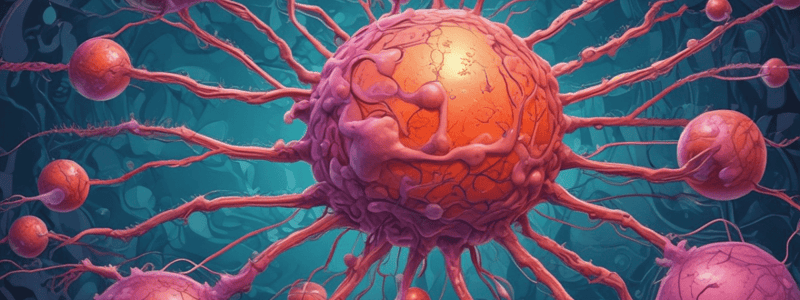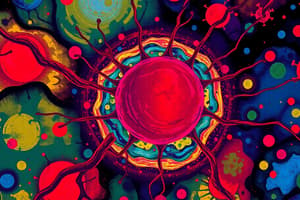Podcast
Questions and Answers
What is the result of a balanced translocation in tumor cells?
What is the result of a balanced translocation in tumor cells?
- Loss of a whole chromosome
- Amplification of a particular gene
- Exchange of segments between two chromosomes (correct)
- Deletion of a segment of a chromosome
What type of chromosomal abnormality is commonly seen in solid tumors?
What type of chromosomal abnormality is commonly seen in solid tumors?
- Gene amplification
- Deletion of a segment of a chromosome (correct)
- Aneuploidy
- Balanced translocation
Which of the following genes is amplified in neuroblastoma?
Which of the following genes is amplified in neuroblastoma?
- HER-2
- BCR-ABL
- RET
- N-MYC (correct)
What is the term for a chromosome number that is not a multiple of 23 in humans?
What is the term for a chromosome number that is not a multiple of 23 in humans?
What is the function of BCL-2 in apoptosis?
What is the function of BCL-2 in apoptosis?
What is the result of gene amplification in tumor cells?
What is the result of gene amplification in tumor cells?
What is required for the development of cancer?
What is required for the development of cancer?
Which gene is responsible for protecting tumor cells from apoptosis in follicular lymphoma?
Which gene is responsible for protecting tumor cells from apoptosis in follicular lymphoma?
What is the role of TP53 in apoptosis?
What is the role of TP53 in apoptosis?
What is the first step in the process of invasion and metastasis?
What is the first step in the process of invasion and metastasis?
What is the function of proteolytic enzymes in invasion and metastasis?
What is the function of proteolytic enzymes in invasion and metastasis?
What determines the metastatic site of a tumor?
What determines the metastatic site of a tumor?
What is the role of vascularization in tumor growth and metastasis?
What is the role of vascularization in tumor growth and metastasis?
What is organ tropism in the context of metastasis?
What is organ tropism in the context of metastasis?
What is the primary reason individuals with inherited defects in DNA repair genes are at greater risk for cancer development?
What is the primary reason individuals with inherited defects in DNA repair genes are at greater risk for cancer development?
What is the outcome of environmental hazards causing DNA damage in normal cells?
What is the outcome of environmental hazards causing DNA damage in normal cells?
What is the result of the failure to repair DNA damage in cells?
What is the result of the failure to repair DNA damage in cells?
What is the characteristic of tumor cells that are more adept at evading host defenses?
What is the characteristic of tumor cells that are more adept at evading host defenses?
What is the role of BRCA1 and BRCA2 in familial breast cancers?
What is the role of BRCA1 and BRCA2 in familial breast cancers?
What is the result of clonal expansion of tumor cells?
What is the result of clonal expansion of tumor cells?
What is the characteristic of hereditary nonpolyposis colon cancer syndrome (HNPCC)?
What is the characteristic of hereditary nonpolyposis colon cancer syndrome (HNPCC)?
What is the outcome of genetic damage during carcinogenesis?
What is the outcome of genetic damage during carcinogenesis?
What is the role of VEGF in tumor cells?
What is the role of VEGF in tumor cells?
What is the function of HIF in response to hypoxia?
What is the function of HIF in response to hypoxia?
What is the role of the VHL gene in tumor suppression?
What is the role of the VHL gene in tumor suppression?
What is the reason for cellular senescence after 60-70 cell doublings?
What is the reason for cellular senescence after 60-70 cell doublings?
What is the effect of P53 and RB mutations on cellular senescence?
What is the effect of P53 and RB mutations on cellular senescence?
What is the role of telomerase in cancer cells?
What is the role of telomerase in cancer cells?
What is the result of multiple mutations in different cells during tumor progression?
What is the result of multiple mutations in different cells during tumor progression?
What is the significance of VEGF antibody in cancer treatment?
What is the significance of VEGF antibody in cancer treatment?
Flashcards are hidden until you start studying
Study Notes
Resisting Cell Death (Apoptosis)
- BCL-2 controls apoptosis by balancing pro-apoptotic (BAX, BAK) and anti-apoptotic molecules
- Apoptosis can be activated by intrinsic (mitochondrial) and extrinsic pathways, leading to caspase activation
- Mitochondrial membrane permeability is regulated by BCL2
- In 85% of follicular lymphoma cases, the anti-apoptotic BCL2 gene protects tumor cells from apoptosis
- TP53 is a pro-apoptotic gene that induces apoptosis in cells with irreparable DNA damage
Activating Invasion and Metastasis
- Divided into three steps: invasion of extracellular matrix, vascular dissemination, and homing of tumor cells
- Invasion involves detachment of tumor cells from each other, degradation of basement membrane and interstitial matrix, and attachment to new binding sites
- Vascular dissemination and homing of tumor cells involve adhesion to vascular endothelium and entrance into other organ parenchyma
- Metastatic site prediction is influenced by primary tumor location and vascular and lymphatic drainage
- Organ tropism is exhibited by some tumors, possibly due to activation of adhesion or chemokine receptors
Inducing Angiogenesis
- Vascularization of tumor cells is essential for growth and metastasis
- Hypoxia activates HIF1α, leading to transcription of VEGF genes and subsequent angiogenesis
- VEGF secreted by tumor cells leads to new vessel formation
- HIF1α is inactivated by VHL gene (tumor suppressor gene)
- VEGF antibody is approved for treatment of some cancers
Enabling Replicative Immortality
- Cells lose capacity to divide and enter senescence after 60-70 cell doublings due to telomere shortening
- Short telomeres are recognized as DNA damage, leading to cell cycle arrest mediated by P53 and RB
- Cancer cells can reactivate telomerase, achieving immortality
- Cells with mutation in P53 and RB genes cannot recognize DNA damage and continue to divide
The Molecular Basis of Cancer
- Carcinogenesis is a multistep process resulting from multiple genetic alterations
- Tumor progression and heterogeneity result from multiple mutations accumulating independently in different cells
- New subclones arise from the descendants of the original transformed cell by multiple mutations
- Environmental hazards, inherited mutations, and DNA damage contribute to carcinogenesis
Genomic Instability
- Normal cells are able to repair DNA damage
- Individuals with inherited defects in DNA repair genes are at greater risk for cancer development
- Examples include Hereditary non-polyposis colon cancer syndrome, Xeroderma pigmentosum, and BRCA1 and BRCA2 in familial breast cancers
Karyotopic Changes in Tumors
- Genetic damage during carcinogenesis can result in small (point mutations) or large chromosomal changes
- Common types of structural abnormalities in tumor cells include balanced translocations, deletions, gene amplification, and aneuploidy
- Examples of balanced translocations include the Philadelphia (Ph) chromosome in chronic myelogenous leukemia and t(8;14) in Burkitt’s leukemia/lymphoma
Studying That Suits You
Use AI to generate personalized quizzes and flashcards to suit your learning preferences.




